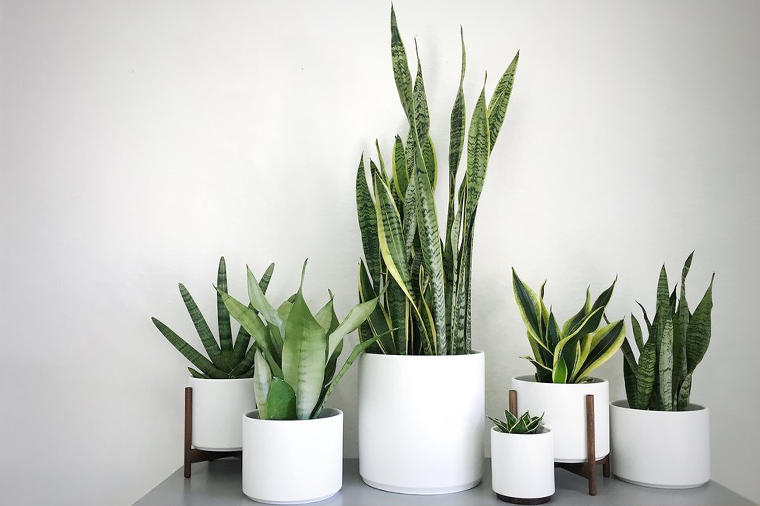All About Snake Plants
Snake plants are known by many interesting aliases, such as mother-in-law’s tongue, devil’s tongue, Saint George’s sword, and viper’s bowstring, among others. However, it’s their botanical name that seems to raise the most confusion these days. In 2017, the snake plant was reclassified from the genus Sansevieria to the genus Dracaena. Modern science has now determined that snake plants, originally named after a person, actually belong to the pre-existing genus, Dracaena within the plant kingdom. Despite this change in their official name, many snake plants are still sold under the name Sansevieria.
Snake plants include about 70 species of flowering plants native to tropical West Africa from Nigeria east to the Congo. However, most varieties we see as houseplants in Northern America have adapted to desert environments and are considered to be succulents, tolerant of dryer conditions.
Snake plants are one of the easiest house plants to maintain, perfect for the first-time plant parent!
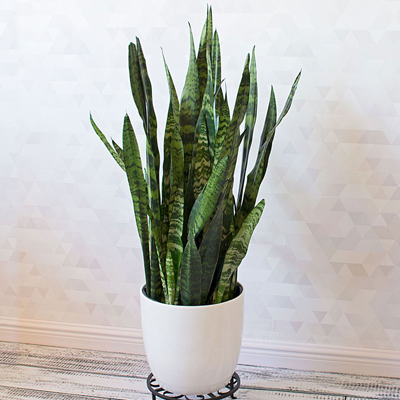
Dracaena trifasciata “Black Coral”
One of the most popular varieties with a vertical growth habit, featuring dark green leaves variegated with wide gray-green wavy horizontal bands. This variety can grow up to 3-4 ft tall.
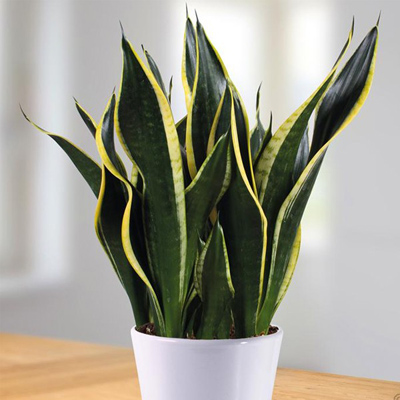
Dracaena trifasciata “Black Gold”
Another popular variety with an upright growth habit features blackish-green leaves variegated with bright yellow margins. This variety can grow up to 3 ft tall.
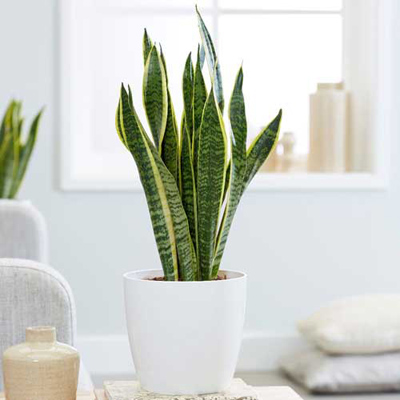
Dracaena trifasciata “Laurentii”
This variety also has an upright growth habit featuring the same variegated look of the Black Coral, but with the addition of creamy yellow margins. This variety can grow up to 3-3.5 ft tall.
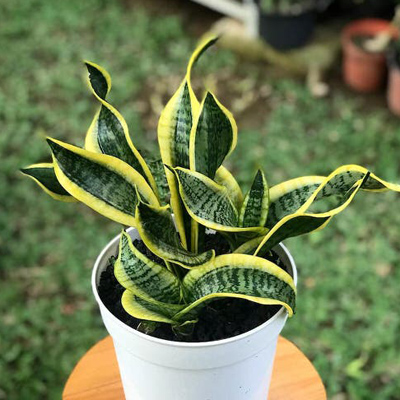
Dracaena trifasciata “Twisted Sister”
This unusual variety is named for its interesting growth habit. New leaves emerge from the base of the plant in a rosette-like pattern and twist as they grow. The Twisted Sister has variegated leaves with bright yellow and dark green and typically matures to 1-1.5 ft tall.
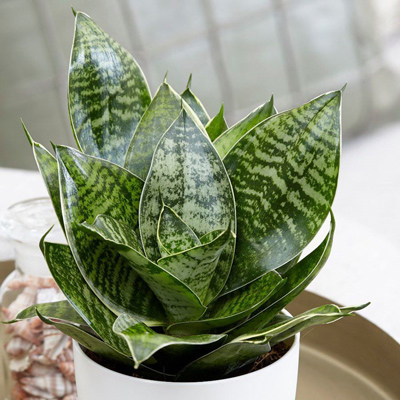
Dracaena trifasciata “Black Robusta”
This variety also has a rosette growth habit, but instead of twisting narrow leaves, it features broad shorter leaves with the same colouring as the “Black Coral”. This variety is considered a dwarf variety and will only grow up to 2 ft tall.
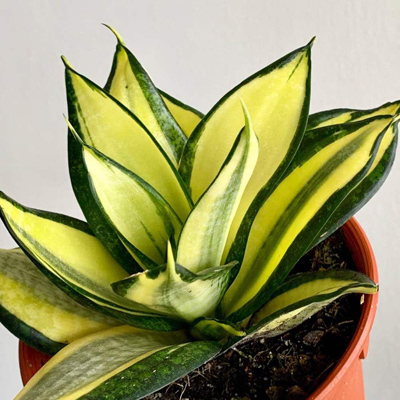
Dracaena trifasciata “Golden Hahnii”
Another dwarf variety with a rosette growth habit, the Golden Hahnii features variegated shorter leaves with dark green leaves with bright yellow variegated margins. This variety will only grow up to 1 ft tall.

Dracaena trifasciata “Moonshine”
This beautiful variety is named for its unusual broad silvery-sage green leaves that darken to olive green as it matures. The Moonshine is another dwarf variety with an upright growth habit, but leaves will only reach up to 1 ft tall.
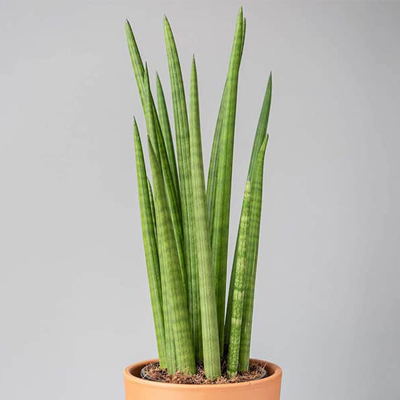
Dracaena angolensis
Formerly known as Sanservia cylindrica, this variety features long narrow variegated green leaves that are uniquely smooth and cylindrical. This variety can grow to be up to 4ft under the right conditions.

Dracaena angolensis “Boncel”
Also known as the starfish snake plant, this subvariety of the Cylindrical Snake plant has the same smooth grey-green cylindrical leaves but grows from a central stem in a fan shape arrangement. This variety can also grow up to 4ft under the right conditions.
Plant Care
Light
Select a place that gets bright, indirect light. Snake plants are very tolerant of a variety of in-direct lighting conditions and are one of the few plants that will tolerate low-light situations. However, the more indirect light they receive the larger they will grow and the more often new growth will emerge.
Temperature
Snake plants prefer temperature ranges between 55-85 °F.
Soil
Snake plants do best in potting soil with excellent drainage, such as a cactus mix, but they will also easily tolerate standard potting mixes so long as you are mindful to let them mostly dry out between waterings.
Water
Since snake plants are succulents, they are very drought-tolerant and they prefer to dry out in between waterings. Make sure your pot has good drainage and allow all the excess water to completely drain out. Be sure to water less often in the winter while the plant is dormant.
Humidity
Snake plants are among the more tolerant of common houseplants and will tolerate low humidity quite well. However, for optimal growing conditions these plants do prefer a relative humidity of 40%.
Pot Size
Choose a pot size that is proportionate to your plant. If there is more soil surface area than plant in its pot, the pot is likely too big and you may struggle to keep it happy. When a pot is too big, it will have too much soil. Too much soil means it will take longer for the soil to dry out between waterings and your snake plant will become waterlogged.
Repotting
Snake plants do not need big pots, they like to get pretty crowded in their pots before they need a bigger pot. Most people will split their plants rather than repot them in bigger pots.
Splitting
Snake plants spread underground through a network of rhizomes. A rhizome is a horizontal underground stem that puts out lateral shoots and adventitious roots at intervals. From these rhizomes, new snake plants will emerge adjacent to the mother plant. Once a baby snake plant has established its own feeder roots, the rhizome can be safely cut and the baby plant transplanted to its own pot. Larger more established plants with many rhizomes can also split at any time. Just be sure to remove the plant from its pot, carefully shake away as much soil as possible to get a clear view of the rhizomes, and use a clean knife to split the plant at the intended rhizomes.
Toxicity
Snake plants are considered to be toxic to both cats and dogs.
Plant Problems
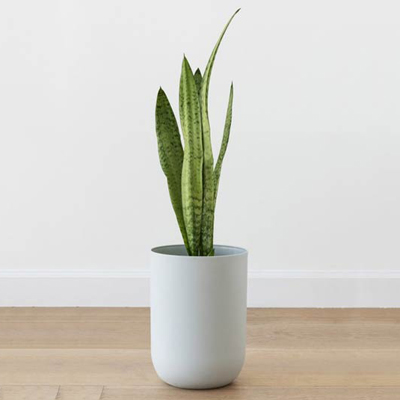
Slow to No Growth
Snake plants are slow growers, but if you do not notice any new growth by the end of the summer season, your plant may not be getting enough of its needs met.
Possible Problems :
1. Not Enough Light – Snake plants prefer mid to bright indirect light for optimal growth.
2. Not Enough Humidity – They prefer 40% humidity, placing them in a bright bathroom, using a humidifier, or misting them regularly might help.
3. Not Enough Room – If your make plant is looking pretty crowded in its pot it may be time to split your plant or pot up to larger pot size.
4. Not Enough Nutrients – If your plant has been in the same soil for some time, it may benefit from some added amendments to the soil or regular fertilizing.

Leaves Falling Over
Healthy snake plant leaves are long upright leaves that stand rigid. Sometimes these leaves may droop, turn white or yellow, and fall over. These are signs your snake plant is unhealthy and you will need to identify what could be causing the issue.
Possible Problems :
1. Too Much Water – Overwatering is the most common culprit for unhealthy snake plants. The plant stores water in its leaves and when there is too much water the leaves can become heavy and droop.
2. Not Enough Light – Despite its tolerance for low light environments, if your plant is not getting enough light its leaves may begin to fall over.
3. Potting Issues – Snake plants need a pot that’s not too big, or too small and has a potting mix that will allow for adequate drainage and aeration to avoid things like root rot, fungi issues, or lack of nutrients.
Treatment :
Identify the likely culprit and take steps to rebalance the environment to more favorable conditions.
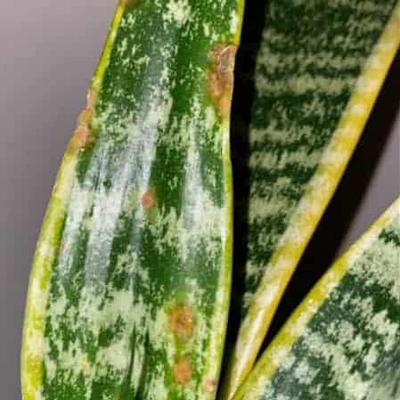
Fungal & Bacterial Issues
Snake plants are prone to fungal and bacterial infections due to overwatering.
Signs of a Problem :
1. Smelly Soil – If your soil has become smelly, your plant is likely struggling with root rot and has likely developed an unhealthy environment as a result.
2. Mushy Roots – Healthy snake plants should have firm white rhizomes. If your rhizomes are mushy and brown then your plant has root rot, which occurs when fungi and bacterias start to decay the roots.
3. Leaf Spots – Brown leaf spots can also be an indication of fungal infections.
Treatment :
In most cases, treatment will involve repotting your plant. To salvage the healthy parts of your plant, remove your plant from its pot and gently shake away and rinse the roots to be clear of the old soil. Using a clean knife, carefully cut away the damaged parts of your plant. Repot your remaining healthy plant in a clean pot with new soil. Be sure to reposition your plant in an area with more light if needed.
Cold Damage
Snake plants can be damaged by sudden temperature shifts. Excessively high temperatures might cause brown rings to appear on leaf surfaces. Extreme cold shifts might result in soft and withered leaf surfaces. To prevent cold damage, keep snake plants indoors and away from cold windows and exterior doors during the winter months.
 |
| 
